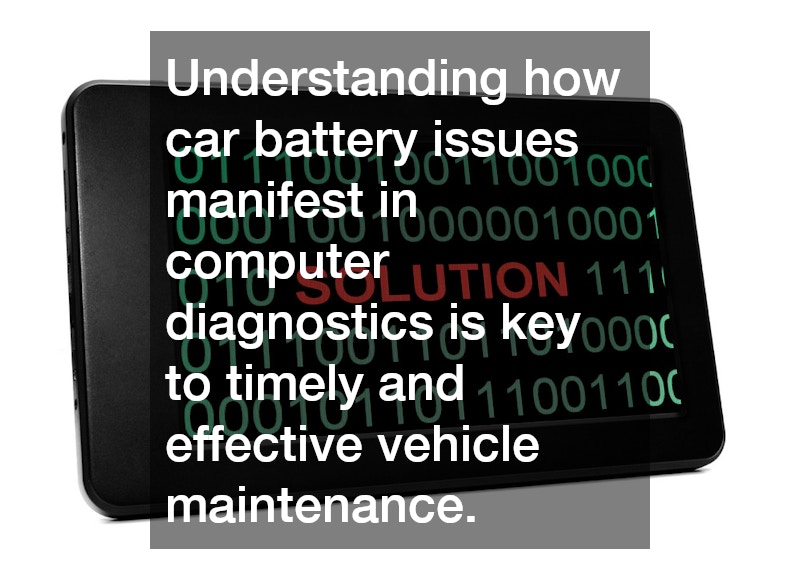In modern vehicles, computer diagnostics play a crucial role in identifying various issues, including those related to car batteries. With advancing automotive technology, understanding how car battery problems manifest in diagnostic reports has become essential for both technicians and vehicle owners. These diagnostics help in preemptive vehicle maintenance by detecting not just obvious battery failures, but underlying issues as well that could escalate if left unchecked.
How does a weak battery affect vehicle diagnostics?
Understanding Battery Voltage Readings
Battery voltage readings are fundamental measurements captured by vehicle diagnostic tools. These readings typically show the battery’s charge state and can flag potential issues. An unusually low voltage reading can indicate a weak or aging battery, prompting further investigations into the vehicle’s electrical system.
Interpreting voltage correctly is vital for both diagnosticians and car owners. Consistent low voltage can affect vehicle performance and might lead to unexpected breakdowns. It’s essential to regularly monitor and maintain an optimal battery voltage to ensure the smooth operation of various vehicle systems.
Diagnostic tools often display these readings in an easy-to-understand format, allowing for quick assessment. The vehicle’s manual might provide information on optimal voltage levels to look out for. Staying within the recommended voltage range can prevent a host of electrical issues, shielding more sensitive electronic components from inadvertent damage.
Error Codes Related to Battery Issues
Error codes in vehicles act as alerts, highlighting specific issues that need attention. A weak or failing battery is often indicated by distinct error codes that can be read using computer diagnostics. Familiarity with these codes allows for prompt troubleshooting and resolution of battery-related problems.
Common codes could include indications of low voltage, irregular power supply, or even total power failure. Diagnosticians often decode these error messages to pinpoint precise problem areas within the battery or broader electrical system. Addressing these alerts early can significantly reduce repair costs and mitigate the risk of more serious disruptions.
Battery-related error codes can often be indicative of larger systemic issues. They provide the initial warning signals, unavoidable in thorough diagnostic scrutiny. Regularly attending to these error codes ensures that the vehicle remains safe and functional for use over time.
Impact on Diagnostic Accuracy
A weak battery can significantly distort diagnostic results, leading to misinterpretations. This skewing effect can cause technicians to overlook or misidentify actual problems, complicating repairs and troubleshooting. Understanding this impact helps in recalibrating diagnostic approaches for clearer evaluations.
The inconsistency brought on by a weak battery may trigger false positives regarding system malfunctions. It is crucial for technicians to assess battery health before commencing extensive diagnostic procedures. By doing so, they can reduce the risk of incorrect assessments and prioritize actionable insights.
Ultimately, a reliable battery provides a stable base for diagnostics, ensuring more consistent and accurate readings. Maintaining the battery ensures more reliability across all vehicle diagnostics. This practice streamlines the maintenance schedule and indirectly benefits the overall health of the vehicle.
What are the warning signs of battery problems in diagnostic reports?
Common Diagnostic Alerts
Diagnostic tools often issue alerts for various vehicle components, including the battery. Common alerts related to battery health can include “low charge,” “alternator issues,” or “battery replacement advised.” These warnings are intended to prompt prompt review and servicing to prevent roadside battery failures.
The presence of such alerts can signal immediate checks and diagnostic re-evaluations. Small alerts now can preempt larger electrical failures down the road. Technicians and car owners alike need to understand these signals as early warning systems for broader maintenance needs.
Understanding these alerts allows for timely intervention, minimizing the risk of unexpected breakdowns. Ignoring them can lead to more acute stress on other electrical systems. Regularly addressing them extends the battery’s life and, by extension, the vehicle’s reliability.
Interpreting Diagnostic Data
Interpreting the wealth of data diagnostics tools provide is essential for accurately assessing battery health. Key metrics include voltage stability, charge retention, and power delivery efficiency. It’s crucial to read these indicators to understand if the battery is functioning within normal parameters.
Training and experience play a huge role in effective data interpretation. Technicians rely on their knowledge to discern whether a battery’s issues are symptomatic of other problems within the vehicle. As such, incorporating regular checks into scheduled maintenance can help catch problems early.
Understanding how car battery issues manifest in computer diagnostics is key to timely and effective vehicle maintenance. By recognizing error codes, voltage readings, and other warning signs, both automotive professionals and car owners can ensure the longevity and reliability of their vehicles. With proper knowledge and vigilant maintenance, vehicles can be safeguarded against unexpected issues stemming from battery problems.
.

